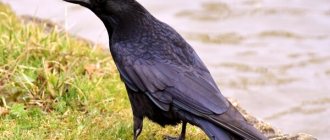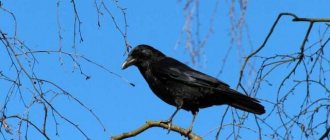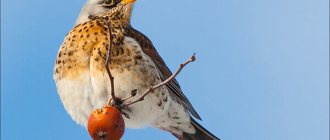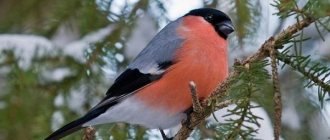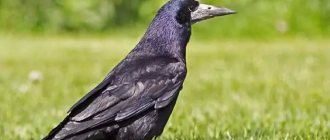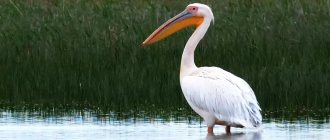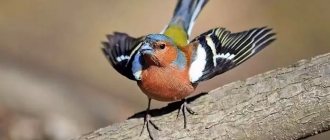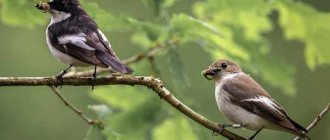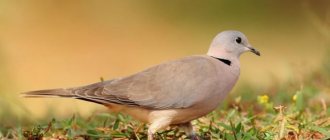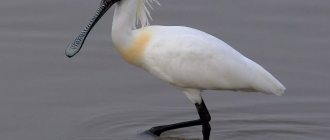The hooded crow is a common and well-known bird. It is easily distinguished from other related species by its two-color coloration. Its head, throat, wings and tail are black, and the rest of the plumage is gray. The bird is quite large: body length 45–51 cm, weight 500–700 g.
The hooded crow is a thriving species, with more and more of them growing every year. As a result, their habits also change. Previously, almost the majority of crows built a new nest every spring. Now they use many nests for several years in a row. And pairs from pairs, especially in cities, began to nest much closer.
Signs of mating behavior of crows appear as early as February. Males, occupying nesting sites, often fly to the same tree and sit for a long time on its top. And on gray cloudy days, sometimes you notice how for some reason a crow climbs into an old nest and does not come out for a long time.
During the thaw, the birds begin spring games in the air, chasing each other, and, as in an air battle, demonstrate aerobatics, sharply diving down or going into a steep tailspin. And then suddenly one of the crows starts playing with the bone - he picks it up in his paws high above the ground, throws it down and tries to pick it up on the fly.
Description and features
Crow is a smart bird . Ornithologists consider this representative of the feathered fauna to be unique. The fact is that these winged creatures are not only superior in intelligence to many members of the animal kingdom. The structure of their mind is comparable to that of a human.
After all, according to research conducted at the University of Cambridge, their ability to think exceeds that of a four-year-old child. These clever creatures are classified among the passeriformes, and are considered to be very large among the members of this order.
They are about half a meter long, and the weight of males reaches 800 grams or more. But females are noticeably smaller.
A bird similar to a crow in proportions and color is a rook (both birds belong to the same genus and family). But the described birds have a denser physique. A crow can also be distinguished by its habits from a rook, in particular by its characteristic manner of nodding its head when walking.
Its beak is black, conical in shape, sharp, and has sufficient power. The wide short wings of these birds, the span of which averages 1 m, are strong and usually pointed (a similar shape is characteristic of most species of crows).
Their legs are long, strong, thin, have three toes pointing forward and one pointing back, that is, four in total.
Ravens, depending on the variety, may have black or gray plumage. It usually sparkles in the sun with a purple or metallic tint, and can also have a greenish tint.
A rare phenomenon in nature is the white crow . This feather color is not considered natural, but is certainly the result of a mutation, a kind of disease called albinism. Since ancient times, such creatures have served as a symbol of alienation and unusualness.
And in natural landscapes, as a rule, they are too noticeable and therefore turn out to be easy prey for predators.
The sounds that crows make are guttural and rough, characterized by hoarseness and high pitch. Some believe that the voices of these birds are similar to human laughter. In fact, the sounds they reproduce are very diverse, even multifaceted in tonality and shades, and are designed to communicate to their relatives about their intentions and feelings.
These could be threats, swearing, signals to gather, or expressions of sympathy during mating periods. This once again proves how smart and developed these creatures are.
There is another bird known for its intelligence - the raven. Even for the ancients it served as a symbol of wisdom. It should be noted that, contrary to the opinion of amateurs, a raven and a crow are different birds , and not just creatures of opposite sexes of the same type of bird. Although they belong, both one and the other, to the corvid family.
They even represent the same genus, and it is called: crows. And both of these winged creatures, due to their ingenuity and ability to adapt, spread across the most diverse and vast territories of the planet. They live in Eurasia and northern Africa, and are found on the American continent and in Australia.
However, in terms of external characteristics, these birds have quite noticeable differences. Ravens are larger and more massive. The tail of this bird has a wedge-shaped end, while that of the crow is rounded.
Both birds have keen vision, and the lateral location of the eyes provides them with a wide viewing angle. Their hearing organs are located internally, not externally, and are protected by plumage.
Habits of the Hoodie Crow
Crows are surprisingly agile, although they walk slowly due to their close-toed toes. This bird loves fun. For example, it glides with pleasure, gaining a height of several tens of meters. Swings boldly on the wires. At our dacha, crows noisily roll down the metal roof, having previously folded their wings. Smart birds are incredibly smart. “If they can’t break a strong shell with their beak, they fly into the sky and throw the shell on rocks or on the highway. Once, crows used the Tashkent airfield as nutcrackers. In the mornings, when there was relative calm at the airport, a flock of crows bombed the concrete strip with walnuts gathered from neighboring gardens!” (S. F. Starikovich “Menagerie at the Porch”). There are many facts confirming the abilities of crows. “They famously count to five in their heads. They organized a round-up of crows... If five people entered the shelter, the flock did not return until all the hunters lost patience and went home. If, say, nine people climbed into the shelter, and six or seven came out, the observer crows lost count and, deciding that everything was in order, gave signals to return.” (S. F. Starikovich “Menagerie at the Porch”).
The crow has its worst enemy - the eagle owl. He kills birds at night when they are sleeping. Crows are vindictive. They remember and can attack the dog that chased them a year ago. Occasionally, birds mistake people's fur hats for old offenders and peck them furiously.
Kinds
The name “crow” is usually attributed to several species belonging to the corvid family. All of them have common characteristic features of appearance, which have already been described here, and they can also be seen in the photo of a crow .
The size of representatives of these species of a given family varies greatly. The sizes of most varieties correspond to the parameters that have already been indicated. But representatives of some species are only slightly larger than a sparrow. Let's give them a detailed description.
1. Gray Crow. Sometimes this species and the carrion crow (described below) are considered as one species, only divided into two indicated subspecies. Despite the name, the plumage of these birds is only partially gray, because the head, tail and wings of these birds are black.
Their range includes the territories of the European continent and extends north to Scandinavia, and east to Asia Minor. The species is not considered rare, but on the contrary, very numerous, and the population of these birds has increased greatly in recent years.
However, this is precisely what creates problems, because such an increase has a detrimental effect on the ecosystem.
2. Black Crow . Like the legs and beak, the plumage of such birds is black, but is complemented by a purple or green tint. This species is divided into subspecies, which may have significant differences. For example, birds living in the west of Eurasia and in the east of the continent are not only not the same in their characteristics, but, as it turns out, they even developed independently of one another.
And their separation occurred quite a long time ago, back in the Ice Age. In Russia, representatives of this species live in the Far East and Siberia.
3. Big-beaked crow. Such birds are common in Asia, living in the Far East, Japan, China and nearby areas. From the name it is not difficult to guess that a characteristic feature of this species is a large beak.
Sizes can reach up to 59 cm, but generally vary significantly. The plumage color is black and dark gray.
4. White-necked crow. Despite the name, the color of the birds is still black, but the feathers have a white base. They live in North America in the United States and Mexico, inhabiting shrubby pastures and desert areas.
5. The bronze crow is found in East Africa. The bird's beak, remarkably, is larger in size than its head, very long and thick. The plumage is black, highlighted by a white spot on the back of the head. Body length can reach up to 64 cm.
6. Bristle crow. Her place of residence is North Africa and the Middle East. In color and proportions, these birds are similar to carrion crows, and their plumage, in sufficient natural light, casts a bluish purple or brownish-copper tint.
The voice produced by these creatures is similar to the croaking of a frog. These creatures usually nest on rocks.
7. Australian Crow. Its black plumage gives off a greenish, purple or glossy tint. The legs and beak are also black. The neck feathers of these birds stand out significantly.
Based on this characteristic feature, as well as the half-meter size (these are the largest parameters for crows on the Australian continent), it is possible to distinguish representatives of this species from others.
8. South Australian Crow. This variety is slightly smaller than the previous one, although only slightly, and the beak of its representatives is thinner. Also, unlike the species just described, these birds tend to form huge flocks. Their color is completely black.
9. Bangay crow is a small species, the size of which is about 39 cm. These birds are black in color. This species is in danger of extinction.
Hatching chicks
With the arrival of spring, the mating season begins. At this time, it is interesting to watch the males performing incredibly complex turns, takeoffs and other aerobatics in the air. The hooded crow nests in pairs. Sometimes nests are located nearby. Crows are very sensitive birds. They are well versed in environmental issues. In polluted areas, the hooded crow rarely builds a nest. She only flies there in search of food, and builds a nest in a cleaner place so that the offspring are healthy.
In March - April, the construction of a nest on a tree or building begins. Building material is whatever the crows are able to find and bring. These are branches, hay, rags, various pieces of iron and pieces of wire. The clutch consists of 2 - 6 bluish-green eggs with dark brown spots and streaks. The eggs laid first are more intensely colored than the last eggs. At the very end, the female lays pale blue eggs with almost imperceptible speckles. Family responsibilities are distributed as follows: the female incubates the eggs, and the male provides her with food. “Through binoculars you can clearly see that there is noticeable movement in the nest. The bird rises a little and seems to half-stand for several moments, quickly moving its legs, causing its wings and whole body to tremble. These seemingly strange actions of the bird help to ventilate the nesting tray. It lasts from a few seconds to half a minute and is repeated so often that the bird, in fact, never sits quietly on the eggs.” (S.F. Starikovich “Menagerie at the Porch”).
The chicks hatch after about three weeks. It is noted that the first crow to hatch is the “boy”. As soon as the chicks are born, the female hooded crow starts searching for food. Birds guard the nest with chicks in turns. Growing chicks need food that is easily digestible and has enough calories. The best food product is the eggs of other birds. Crows mercilessly rob other people's nests to feed their chicks. They also hunt the chicks of smaller birds. “Sitting on a perch stick (and who invented that?) or on the overhanging roof of a birdhouse, the crow waits for the chick to look out the window. Grabbing him by the beak, she drags away the foolish ones one by one. But this is not the height of robbery: some crows uncork birdhouses like a bottle of beer. At the Zvenigorod Biological Station of Moscow State University, a burglar, using her beak as a lever, threw off the lids from eight birdhouses in one morning. Putting her beak between the lid and the side wall, she widened the gap until the lid gave way.”
Lifestyle and habitat
A crow is a bird that can nomad, moving from place to place. There are cases when crows ringed in Russia were found in Western Europe and vice versa. Apparently, for some unknown reason, they simply decided to change their place of residence.
Some of them migrate seasonally, moving in winter to regions with a comfortable climate. It happens that crows do not travel at all, but live sedentary. But in any case, the birds described are not capable of making too large movements, as, for example, swallows do.
It is interesting that crows are not only intelligent, but also know how to remember for a long time and somehow transmit certain information to others. Once upon a time in Canada, the town of Chatham was occupied by hordes of such feathered guests and turned out to be very unwelcome guests there.
They destroyed crops and harassed local residents. As a result of the war that people declared against the winged pests, one crow was killed. And this was enough for the birds to leave this refuge.
Moreover, the flocks of crows no longer stopped in this locality. Moreover, this is not an isolated case. There is a lot of evidence that crows try to avoid the places where their fellow tribesmen died.
Experiments conducted by scientists prove that the described representatives of the feathered kingdom are capable of solving the tasks assigned to them, and in a very clever way. They pulled a hard-to-reach treat attached to a rope, thus getting what they wanted. And when taking worms out of a narrow vessel with water, they threw pebbles into it, displacing the liquid and getting to the prey.
In nature, these birds are distinguished by their mobility, and they are also characterized by judicious caution. They usually live in flocks, and members of this community show a desire to develop the occupied territory. But among the crows there are also loners.
These representatives of the feathered fauna develop their activities during the day. And at night they are used to resting from troubles and worries, which they usually do when gathering in groups. When moving in the air, crows flap their wings quite rarely. People, especially in windy weather, often watch crows simply soar, flying around bell towers, spiers or high-rise buildings.
Keeping at home
Pay attention to the nuances of keeping a crow at home:
- It is necessary to allocate a free area for the birds to fly, and also secure the perches. Make a floor on the floor and regularly clean the area designated for keeping the crow.
- Take care of a balanced diet, drinking regime and organization of water procedures.
- For taming, it is best to take a crow no more than 2-3 months old.
- It is not recommended to have such a pet if you have small children. Also, the crow will not get along with animals or birds that are smaller than it.
Hooded crows can make excellent long-term pets (their lifespan is about 20 years). Over time, they get used to people, recognize their owner, and after training they can reproduce individual phrases of human speech. To do this, you need to talk to the bird as much as possible, pronouncing the words clearly and loudly.
If the article was useful to you, then like it. And in the comments, write what funny stories you know about domestic gray crows.
Nutrition
The crow begins to search for food These birds are essentially omnivores. They are often unceremonious in obtaining food, which brings trouble and trouble to people. For those birds that settle close to human habitation, food waste is acceptable food, and even a favorite delicacy. That’s why crows often gather in large numbers at landfills.
But, in fact, the diet depends on the place where the birds live. They can eat vegetables and fruits, nuts, acorns, and plant seeds, if there are a lot of them in the areas where they live. These birds rummage through manure to find and eat insect larvae. They often offend their winged brothers: visiting their nests, they destroy them, eat eggs, even chicks.
Some of the crows live by hunting. For the successful implementation of this enterprise, they can unite into groups. And at the end of the work they arrange a general feast. Their victims can be small rodents, frogs, lizards, even larger prey.
What can we say about butterflies, flies and beetles, which are also included in the diet of these birds. Crows often adapt to follow other seasoned predators. Following them, they feed on the leftovers from their meals.
The intelligence of crows when obtaining food is manifested in its entirety. If such a smart bird, for example, wants to eat a nut, but cannot crack it, then it is quite capable of thinking of throwing it on the road and eating it later, when it is crushed by a car.
There are also many other cases where a crow used various objects and devices from its environment to get food.
How to care for a chick
Crow chicks may fall out of the nest. Parents often find their chicks and return them to safety. At the same time, they can repel some predators and even people, calling other birds to help. Birds distract attention from their offspring by scratching with their claws and moving closer to the vulnerable spots of uninvited guests, such as the eyes.
In some cases, the chick is still left alone, which means certain death for it. After all, newly born babies are defenseless, blind and need warmth.
You can feed the yellowthroat chick that you have taken under your care with a liquid mash of chopped vegetables, meat, porridge and cottage cheese. When eating, use a syringe with a rubber tip or tweezers to lower food into your pet's beak. When the crow grows up and becomes a fledgling, the mash can be made thicker.
A person's responsibility to their pet is very great. Hooded crows raised in captivity will no longer be able to adapt to life in the natural environment.
What kind of eggs does a swallow have?
The female lays 3-7 white eggs with brown-red, gray or purple specks, but most often 5 eggs. Both parents incubate the eggs
, whose incubation period is 13-15 days.
Interesting materials:
How to block Internet access on a computer? How to block a flash drive on a computer? How to block the Internet on your computer for a while? How to block the Internet on a computer? How to block a YouTube channel on a computer? How to childproof your computer? How to block a contact on Skype on a computer? How to block a number on Viber on a computer? How to lock a running computer? How to block sites on your computer from children?
Receiving the quest Edit
Arriving for the first time at Skadovsk, in the medic’s cabin Degtyarev hears a conversation between Gonta and Garmata. After the end of the conversation, Gonta turns to GG with a question about whether Degtyarev has met Soroka. After which he explains that they did not have enough hunters to track down the chimera, since Danila went to track down the lair of the bloodsuckers. Magpie was asked to help, since the hunters helped him free his cache from the controller, and he agreed. According to Gonta, all he had to do was stand on the lookout near the lair and let them know when the chimera appeared. But instead, Soroka abandoned the group to destruction. Because of him, the Crab suffered, and Gonta wants revenge.
Capabilities
After conducting a series of scientific experiments with crows, scientists found that they are able to determine the sequence of events and form complex reflexes from several signals. Ornithologists believe that birds are capable of solving simple logical problems. They have mutual imitation and learning of complex behavior.
Crow chicks are very easy to tame and quickly increase their intelligence when interacting with their owner. The bird can be taught many tricks, for example, bringing a spoon to the table, taking off a guest's hat. But the owner of a domestic crow must be on guard all the time and hide valuables well, since everything that glitters will be stolen by the crow and hidden securely in its hiding places.
Tags: raven, city, many, why
Signs March 22
- Jackdaws and magpies are found in large numbers, which means it will soon be warm;
- What is the weather like in Soroca, it will be like this for another 39 days;
- If you hear thunder - it means a hungry year; If the frost lasts forty days, then it will be warm in the summer;
- Among the people, 40 saints are associated with the beginning of spring and the end of winter, so on this day they monitored the weather: what it would be like on March 22, the next 40 days would be like that.
- Although it is already a completely spring day, however, the echoes of winter, albeit faint, can still be heard. 40 birds fly to Soroki. Day and night measure up - spring begins. Warm magpies - forty days will be warm, cold magpies - expect forty cold mornings.
- As for the magpies, so does Petrovka (July 12). If on the day of the Forty Martyrs it melts so much that an ox can drink enough, then there will be a good spring. If the magpies pass without melting, the summer will be warm. What the weather is like on this day, it will be like that for another forty days. For forty martyrs - the arrival of larks: as many thawed patches, as many larks. Morning frosts begin and last for forty days. Having missed forty frosts after forty martyrs (after forty days), I eat this buckwheat. The tit began to sing - it bewitches warmth. Forty birds arrive, forty birds make their way to Rus'. The snow is melting and there is a friendly flood - wait for good grass. The wagtail will fly to Nikola - in twelve days the river will flow. The seagull has flown in - soon the ice will melt.
